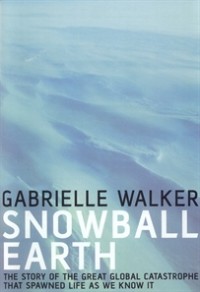Scratch a geologist and, under their skin, you’ll find a romantic

Snowball Earth: the Story of the Great Global Catastrophe That Spawned Life as we Know it
by Gabrielle Walker
I picked up this book because Walker came highly recommended, not because of the subject matter. In fact, the one aspect of the book I had been interested in (the biology angle) was squeezed largely into one chapter. It turns out that this is a book about geology, which I have very little knowledge of or interest in, yet I found it hugely readable and genuinely enjoyable.
I will attempt to explain the premise briefly. The Earth is about 4.5 billion years old. The first lifeforms – single-celled slime, often called the “primordial ooze” – emerged about 3.7 billion years ago. The first multi-cellular creatures – the ancestors that led to complex beings such as us humans – didn’t show up until 600 million years ago. Scientists had long been puzzled as why it took so long for evolution to really get started and whether there had been some kind of trigger. In the late 20th century geologists finally found what looks like the answer – the Snowball Earth.
“Stretch your arms out wide to encompass all the time on Earth. Let’s say that time runs from left to right, so Earth was born at the tip of the middle finger on your left hand. Slime arose just before your left elbow and ruled for the remaining length of your left arm, across to the right, past your right shoulder, your right elbow, on down your forearm, and eventually ceded somewhere around your right wrist. For sheer Earth-gripping longevity nothing else comes close. The dinosaurs reigned for barely a finger’s length. And a judicious swipe of a nail file on the middle finger of your right hand would wipe out the whole of human history.”
But what is the Snowball Earth? The idea is that sometime around 650 million years ago the Earth froze completely over, even at the equator, for a few million years. There’s a lot of geological evidence pointing to this having happened, possibly multiple times in quick (geologically speaking) succession, and it is the theory that best answers a lot of questions raised by odd rock formations and other geological anomalies. However, it’s also a controversial idea that has taken a lot of time and accumulated evidence to reach the state of semi-approval it currently has.
It really is to Walker’s credit that she has made a book about looking at rocks so very appealing to me. I think this is partly because she puts the emphasis firmly on the people and personalities involved. This book is as much about Paul Hoffman, a professor of geology at Harvard, as it is about anything else. Walker depicts him as quite the character, difficult and brilliant, with long-standing rivalries and a long string of we-used-to-be-friends, but her picture is still a warm one.
“There’s something about holding a geological hammer that makes you want to hit rocks. Weigh one in your hand, and you’ll find yourself itching to whack something with it. Still, to carve a hand sample into just the right shape for your pocket requires considerable skill. Paul is very, very good at it. If his geology career went awry, he could make a living as an ornamental rock chipper.”
The way Walker describes the piecing together of the Snowball Earth theory is very enlightening as regards the scientific process, elucidating where ideas come from and how they develop, sometimes painfully slowly. She lets the story unfold as it really did – in fits and starts – with only the occasional backpedal to clarify. This can be frustrating at times when suddenly a new character comes into play and has to be introduced but it also cannily introduces suspense: How is this new person connected to everything else? And how will they affect Paul’s story?
“Relationships among geologists are intense. By its nature, geology involves travelling with your colleagues to remote places…living on top of one another and away from other people for weeks on end…Their personalities become magnified. They bond or they break.”
Walker’s explanations of the actual science are largely excellent, though she does occasionally simplify a little too far – who doesn’t know at the basic level what DNA is? But I came away from this book really feeling that I understood it all and curious about what further developments have been made in this area since the book was published 11 years ago.
There are some beautiful descriptions both of the remote locations the geologists travel to to find the right rock formations and of geology itself. Walker paints a romantic view of geology, showing love for the subject and affection for all the people involved in the tale. Perhaps it’s this warmth that drew me in. I’m certainly intrigued to read more of her works and see if she can make other unlikely subjects come alive for me in the same way.
“Scratch a geologist and, under their skin, almost invariably, you’ll find a romantic. They will often be gruff about the landscape they work in. They are usually matter of fact about the rocks and how they interconnect. But try asking why they’ve chosen to spend their lives working on this particular place or on that particular terrain, and that’s when the stories start to slip out.”
Published 2003 by Bloomsbury.
Source: Borrowed from the library.
Challenges: This counts towards the 2014 Popular Science Reading Challenge.